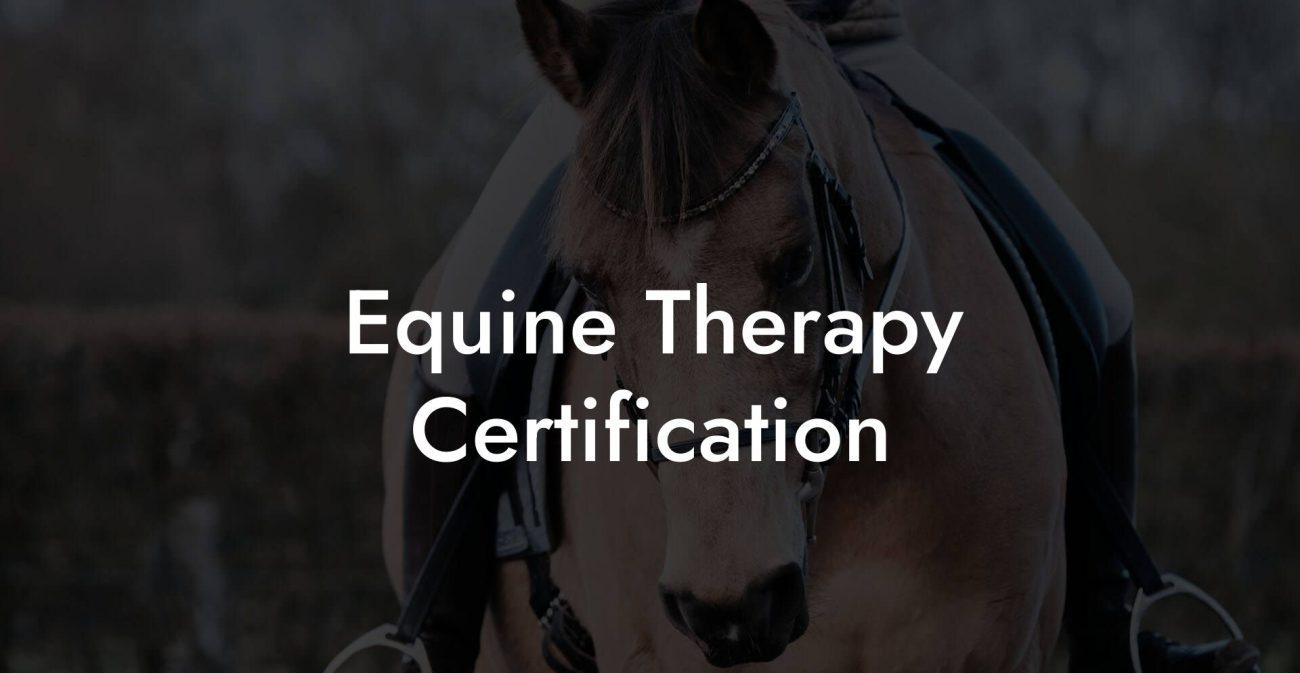Picture yourself riding into a future where the scent of fresh hay, the steady rhythm of hooves, and a life of freedom converge with savvy business acumen and a heart full of passion for horses. Whether you're daydreaming at your desk or scrolling through social media at midnight, this guide is your golden ticket to starting a horse ranch that’s as smart, sustainable, and stylish as you are. We’re talking about building an equestrian empire that’s equal parts entrepreneurship and genuine horse care, a space where millennial hustle meets country charm.
Quick Links to Useful Sections
- The Dream and Reality of Starting a Horse Ranch
- Vision and Ambition: Setting Your Equestrian Goals
- Business Planning: Charting Your Course to Equestrian Success
- Finding the Perfect Piece of Land: Location, Location, Location
- Legal and Financial Considerations for Your Ranch
- Permits and Zoning
- Insurance and Liability
- Financial Projections
- Horse Selection and Care: Building Your Equestrian Team
- Selecting Your Horses
- Caring for Your Equine Stars
- Building the Infrastructure: Stables, Arenas, and Beyond
- Designing Functional Stables
- Creating Training and Riding Arenas
- Additional Facilities
- Operational Management: Running a Smooth and Successful Horse Ranch
- Daily Routines and Scheduling
- Staffing and Training
- Technology and Modern Tools
- Marketing Your Horse Ranch: Herding Attention in the Digital Age
- Building a Compelling Brand
- Social Media and Content Marketing
- Local SEO and Digital Presence
- Integrative Horse Care: Balancing Tradition and Innovation
- Traditional Horse Care Practices
- Modern Innovations in Equine Health
- Sustainable and Eco-Friendly Practices
- Overcoming Challenges and Learning from the Field
- Resources and Community Support: Your Next Steps
- FAQ: How to Start a Horse Ranch – Your Questions Answered
- Your Journey to Equestrian Freedom: Embrace the Ranch Life
The Dream and Reality of Starting a Horse Ranch
The idea of launching your own horse ranch might seem like living out a country-western fantasy, complete with wide open spaces, spirited equines, and sunsets that make your Instagram pop. But like any epic adventure, starting a horse ranch is part dream, part hard work, and a whole lot of planning. In this guide, we’ll break down everything from the initial spark of inspiration to the nitty-gritty of setting up a functioning, profitable equestrian business.
Whether you’re into horse care, sustainable farming, or simply chasing a lifestyle that shouts “freedom,” this comprehensive journey is your roadmap. We’ll sprinkle in humor, serve up expert advice, and keep the tone real, because starting a ranch isn’t just about looking cool in a cowboy hat; it’s about blending passion with practicality.
Vision and Ambition: Setting Your Equestrian Goals
Before you invest in land, build stables, or adopt your first four-legged friend, it’s essential to craft a clear vision. Ask yourself: What does the perfect horse ranch look like for you? Is it a riding school, a boarding facility, a breeding operation, or perhaps a mix of everything? Your vision is the foundation on which every decision will be made.
Start by jotting down ideas and researching various ranch models. Look at successful ranches, chat with industry experts, and absorb as many inspirational stories as possible. The process of defining your dream is as important as the actual business plan because it clarifies your mission, values, and long-term goals.
Remember, your vision should be bold enough to push boundaries but flexible enough to adapt as you learn along the way. From a Gen-Z entrepreneur to a millennial ranch visionary, it’s about making your dream sustainable, scalable, and deeply rewarding, not just financially, but emotionally too.
Business Planning: Charting Your Course to Equestrian Success
Every successful horse ranch starts with a rock-solid business plan. This isn’t your typical snooze-fest spreadsheet; this is your blueprint for blending the art of horse care with the science of business management.
Market Research: Dive deep into your local equestrian market. Evaluate your competition, pinpoint your target audience, and understand demand trends. Whether you're aiming to cater to hobby riders, competitive equestrians, or families seeking a weekend retreat, know your niche.
Budgeting and Financing: Starting a ranch requires significant capital, land, stables, horses, and day-to-day operational costs. Explore funding options such as small business loans, grants, and even crowdfunding campaigns. Keeping a close eye on your cash flow is essential, especially during those early stages where every dollar counts.
Business Structure and Legalities: Decide whether your horse ranch will operate as a sole proprietorship, partnership, LLC, or corporation. Each structure has its perks and potential pitfalls when it comes to liability and taxation. Consult with a legal expert who’s familiar with agricultural ventures to ensure that your business is built on firm, compliant foundations.
Brand Identity: In today’s digital age, your brand is your story. From your logo and website design to your social media persona, make sure your identity resonates with the modern equestrian enthusiast. A dash of wit, a pinch of authenticity, and visuals that pop will make your ranch memorable in a crowded online space.
Finding the Perfect Piece of Land: Location, Location, Location
One of the first tangible steps in launching your horse ranch is securing the right piece of land. The land you choose will shape your operations, attract your clientele, and even influence your daily routines. Here’s what to consider:
- Geographical Location: Look for areas with a strong equestrian culture, accessible roads, and favorable climate conditions. Proximity to urban centers can help attract customers who want a taste of rural charm without sacrificing convenience.
- Size and Topography: Determine the acreage needed not only for stables and paddocks but also for future expansion. Consider the terrain, grassy meadows, gentle slopes, and natural water sources can be a boon for a sustainable ranch operation.
- Environmental Considerations: Ensure your land meets local zoning regulations for agricultural use. Soil quality, water rights, and potential hazards (such as flood zones) are all critical factors before signing on the dotted line.
Finding that ideal stretch of land is a blend of research, networking, and sometimes a bit of luck. Don’t be afraid to explore multiple properties and consult local experts who understand the ins and outs of land acquisition in your desired area.
Legal and Financial Considerations for Your Ranch
Setting up your horse ranch involves more than just sheer passion; it requires savvy legal and financial planning. Here are some key areas to focus on:
Permits and Zoning
Before you break ground, verify that your chosen location is zoned for agricultural and equestrian activities. This might involve applying for special permits, environmental impact assessments, or even water usage rights. Engage with local government offices and legal counsel to navigate these regulations seamlessly.
Insurance and Liability
Horse-related businesses face unique risks, from injuries to property damage. Adequate insurance coverage is non-negotiable. Explore policies that cover liability, property, and even specialized coverage for your horses. Protecting yourself and your business is not just smart, it’s necessary.
Financial Projections
Develop detailed financial projections that account for both startup costs and ongoing expenses. Factor in investments for buying land, building stables, purchasing horses, and marketing your venture. A realistic budget, paired with contingency plans for unexpected expenses, will set you up for long-term financial health.
These initial steps might seem daunting, but thorough preparation now will save you headaches and stress later. Consider every legal requirement and financial obligation as essential building blocks of your future success.
Horse Selection and Care: Building Your Equestrian Team
At the heart of any horse ranch lies its equine residents. Choosing the right horses and ensuring they receive top-notch care is paramount to the success of your operation. After all, your reputation will largely rest on happy, healthy horses.
Selecting Your Horses
Consider the following factors when choosing horses for your ranch:
- Temperament and Breed: Depending on your ranch’s purpose, be it training, boarding, or recreational riding, select horses with suitable temperaments and qualities. Thoroughbreds, quarter horses, and mustangs each offer unique advantages.
- Health and History: Always request a full health history, including veterinary records. Healthy horses make for fewer surprises and lower maintenance costs.
- Purpose and Compatibility: Ensure that the horses you choose align with your business goals. A riding school might prioritize gentle, well-trained horses, while a breeding facility might look for strong lineage and performance records.
Caring for Your Equine Stars
Once you’ve assembled your team, establishing a solid routine for their care is vital. This involves:
- Daily Feeding and nutrition: A balanced diet tailored to the specific needs of each horse is critical. Incorporate quality hay, grains, and access to fresh water. Consult with an equine nutritionist if possible.
- Regular Veterinary Check-Ups: Preventative care is key to avoiding costly health problems. Schedule visits with a trusted equine veterinarian for routine check-ups, vaccinations, and dental care.
- Exercise and Mental Stimulation: Horses thrive with regular exercise and social interaction. Develop a work plan that includes riding sessions, turnout time, and mental challenges that keep your horses engaged and happy.
- grooming and Hygiene: Regular grooming isn’t just about looking good. It builds trust between you and your horses and helps you spot any potential health issues early on.
Balancing rigorous care routines with flexibility and compassion not only elevates the well-being of your horses but also creates a warm, inviting atmosphere that attracts enthusiasts from all walks of life.
Building the Infrastructure: Stables, Arenas, and Beyond
A successful horse ranch isn’t just built on dreams; it’s built on solid infrastructure. Whether you’re constructing stables, designing spacious arenas, or planning scenic trails, here’s what you need to consider:
Designing Functional Stables
Your stables are the cornerstone of your ranch’s operations. Prioritize:
- Safety and Comfort: Ensure ample space for each horse, proper ventilation, and easy access to food and water. Non-slip flooring, fire safety measures, and secure fencing are must-haves.
- Ease of Maintenance: Choose building materials that are durable and easy to clean. Incorporate modern technologies such as automated water systems and efficient waste management solutions.
Creating Training and Riding Arenas
Your riding arenas set the stage for training, events, and public demonstrations. Consider building both indoor and outdoor arenas to cater to varying weather conditions. Ensure that the surfaces are well-maintained, dust-free, and safe for both horses and riders.
Additional Facilities
Don’t overlook ancillary structures that add significant value to your ranch:
- Office Spaces: A dedicated space for administrative tasks, meetings, and planning is essential. Modern office designs combined with rustic décor can set the tone for professionalism and charm.
- Feed and equipment Storage: Organize storage solutions to keep feed, tack, and maintenance tools secure and easily accessible.
- Recreation and Community Areas: Think about creating spaces where visitors and staff can relax, a cozy lounge area, outdoor fire pit, or even picnic spots can enhance the overall experience.
Proper infrastructure not only streamlines operations but also elevates the overall aesthetics and functionality of your ranch. It’s an investment that pays off in smoother day-to-day management and a stellar reputation.
Operational Management: Running a Smooth and Successful Horse Ranch
With your vision, plans, and infrastructure in place, the daily operations of your horse ranch become the heartbeat of your business. The key is to create routines that balance the needs of your horses with efficient business management.
Daily Routines and Scheduling
Establish clear schedules for feeding, exercise, grooming, and cleaning. Use digital management tools and mobile apps tailored for equestrian businesses to track appointments, maintenance tasks, and financial transactions.
Staffing and Training
Surround yourself with a team that shares your passion. Hiring experienced trainers, grooms, and administrative personnel can make a world of difference. Invest in regular training sessions and create a supportive work culture that values teamwork and innovation.
Technology and Modern Tools
Integrate modern technology into your daily operations. From RFID tracking for horse identification to software for scheduling and inventory management, embrace tools that streamline your workflow. This fusion of tradition and technology can set your ranch apart in a competitive market.
Operational efficiency not only boosts your bottom line but also ensures that your horses receive the highest standards of care. A well-oiled machine behind the scenes translates into a vibrant, thriving ranch.
Marketing Your Horse Ranch: Herding Attention in the Digital Age
In an era where social media reigns, marketing your horse ranch is as crucial as building your stables. The right blend of digital marketing, SEO, and authentic storytelling can turn your ranch from a hidden gem into a sought-after destination.
Building a Compelling Brand
Develop a brand that reflects both the rugged charm of ranch life and the modern sensibilities of today’s audience. Use high-quality visuals, engaging videos, and a unique voice that resonates with Gen-Z and millennial audiences. Think Instagram reels, TikTok tours, and eye-catching narratives that tell your ranch’s story.
Social Media and Content Marketing
Leverage platforms like Instagram, Facebook, and TikTok to share behind-the-scenes looks at ranch life, horse care tips, and success stories. Blogging, vlogging, and even hosting live Q&A sessions about “how to start a horse ranch” can boost your online visibility and build trust with your audience.
Local SEO and Digital Presence
Optimize your website with keywords such as “horse ranch business,” “caring for a horse,” “equestrian lifestyle,” and “how to start a horse ranch.” Make sure your site is mobile-friendly and fast-loading. Use rich snippets, structured data, and local business directories to increase your search engine ranking.
Your marketing strategy should be as dynamic and robust as your ranch operations. Embrace creativity, stay active on digital platforms, and watch as your story captivates audiences from across the country.
Integrative Horse Care: Balancing Tradition and Innovation
A thriving horse ranch isn’t just about stellar business practices, it’s also about top-notch horse care. Integrating traditional husbandry techniques with modern practices ensures that your equine partners are happy, healthy, and performing at their best.
Traditional Horse Care Practices
Horse care has a rich history, from time-honored grooming rituals to natural remedies passed down through generations. These methods, rooted in patience and respect for the animal, include daily grooming, herbal treatments, and time spent simply connecting with your horses.
Modern Innovations in Equine Health
Today’s ranch managers also have a range of modern tools at their disposal. Equine nutritionists, advanced veterinary diagnostics, and even wearable technology provide data to help monitor a horse’s health in real-time. By merging the old with the new, you create a holistic care environment that favors both tradition and innovation.
Investing in your horses’ well-being isn’t just good for them, it enhances your reputation and builds customer trust. A ranch that consistently delivers top-tier horse care stands out as a beacon of excellence in the equestrian world.
Sustainable and Eco-Friendly Practices
In today’s eco-conscious market, integrating sustainable practices into your horse ranch operations is not only ethical but also a smart business move. Millennials and Gen-Z consumers are more likely to support a business that values environmental stewardship.
Renewable Energy: Consider installing solar panels or wind turbines to power your facilities. This reduces operating costs and minimizes your carbon footprint.
Green Waste Management: Implement recycling programs and composting systems for manure and organic waste. Not only does this help the environment, but it can also create a natural fertilizer for your pastures.
Water Conservation: Invest in rainwater harvesting systems and efficient irrigation methods. Conserving water is crucial in maintaining healthy pastures and reducing overall expenses.
Eco-friendly measures build trust with your community, enhance your brand image, and ensure that your ranch is as sustainable as it is successful.
Overcoming Challenges and Learning from the Field
Every horse ranch faces its fair share of hurdles, unpredictable weather, unexpected veterinary costs, and the occasional misbehaving pony. However, these challenges only strengthen your resolve and sharpen your problem-solving skills.
Flexibility is Key: The ability to adapt to changing circumstances is essential. Whether it’s pivoting your business strategy during an economic downturn or innovating on-the-fly due to new equine trends, resilience is your greatest asset.
Community Learning: Engage with other ranch owners, attend equestrian conventions, and participate in online forums. Learning from others’ experiences can offer invaluable insights and creative solutions to common problems.
Embracing Failure: Not every venture will go as planned, but failures provide opportunities for growth. A misadventure with a new training method or a temporary dip in business can be a stepping stone towards a more refined operation.
Accept the ebb and flow of ranch life, each challenge is simply another opportunity to learn, adapt, and come back stronger.
Resources and Community Support: Your Next Steps
A horse ranch might seem like a solitary venture, but in reality, the equestrian community is vibrant, welcoming, and full of resources. Tapping into these networks can propel your business forward.
Local Equestrian Clubs and Associations: Join clubs and attend local events to connect with fellow ranch owners, trainers, and enthusiasts. These groups often host workshops, training sessions, and networking events, perfect for sharing tips on horse care, ranch management, and business growth.
Online Forums and Social Media Groups: Digital communities on platforms like Facebook, Reddit, and Instagram let you tap into global knowledge. Ask questions, share successes, and even collaborate on projects that benefit the community.
Workshops, Webinars, and Conferences: Look for industry-specific events that focus on both the business and animal care sides of equestrian life. These can provide cutting-edge insights, hands-on demonstrations, and the latest in sustainable ranch practices.
Mentorship Programs: If you're new to the field, seek a mentor who’s been through the ups and downs of starting a horse ranch. Their guidance can be worth its weight in gold.
Tapping into community resources not only eases your burden but also opens doors to collaborations and innovative ideas. Your network is your safety net and your springboard into a thriving equestrian enterprise.
FAQ: How to Start a Horse Ranch – Your Questions Answered
Dive into these frequently asked questions to clear up common uncertainties about starting and managing a horse ranch.
1. What are the initial steps to start a horse ranch?
Getting started involves crafting a clear vision, conducting detailed market research, securing land that supports equestrian activities, and developing a comprehensive business plan tailored to your ranch vision.
2. How do I choose the right location for my ranch?
Look for land in areas with a strong equestrian culture, favorable climate, suitable acreage, and accessibility to key markets. Ensure the property meets local zoning laws and environmental regulations.
3. What legal considerations should I be aware of?
Understanding zoning laws, obtaining the necessary permits, setting up an appropriate business structure, and securing adequate insurance are all critical legal foundations for your ranch.
4. How important is horse care in running a successful ranch?
Exceptional horse care is crucial, as the health and well-being of your horses determine your reputation and operational success. Regular veterinary check-ups, tailored nutrition, and dedicated grooming are key components.
5. What budget should I expect for starting a horse ranch?
Costs vary based on land size, facilities, number of horses, and operational scope. A detailed financial plan with contingency funds is essential, and exploring multiple funding options can ease the initial financial burden.
6. How do I integrate modern technology into my ranch operations?
Modern tools like RFID tracking systems, digital scheduling apps, and advanced veterinary diagnostics can streamline operations while maintaining high standards of care.
7. What marketing strategies work best for a horse ranch?
A mix of digital marketing, engaging social media content, local SEO, and storytelling that reflects the unique aspects of your ranch will attract attention and build a loyal customer base.
8. Can a small horse ranch eventually scale into a larger operation?
Yes, with careful planning and reinvestment of profits, many small ranches successfully scale up over time. Establishing a solid brand and operational foundation is key to growth.
9. How do I stay updated with the latest trends in horse care and ranch management?
Engage with local and online equestrian communities, attend industry conferences, subscribe to relevant publications, and pursue continuous learning to stay ahead of industry trends.
10. What’s the best way to balance the business and passion sides of a horse ranch?
Creating structured routines, leveraging modern management tools, and building a supportive team ensure that you can maintain high standards in both business management and horse care.
Your Journey to Equestrian Freedom: Embrace the Ranch Life
Starting a horse ranch is more than a business venture, it’s a lifestyle that fuses passion with practicality, tradition with modernity, and work with play. You’re about to embark on a journey where every sunrise brings the promise of adventure and every sunset reminds you why you took this leap.
Embrace the challenges, celebrate the victories, and let the lessons from each day propel you forward. Whether you're training your first horse, setting up state-of-the-art stables, or building a brand that speaks to the hearts of fellow equestrians, remember that success is a journey defined by your unique blend of grit, creativity, and compassion.
From the thrilling rush of a successful championship ride to the quiet moments spent grooming a gentle mare, your horse ranch will be a testament to your dedication and vision. So saddle up, let your passion be your guide, and step boldly into a future where the fields are as wide as your dreams and the possibilities as boundless as the open sky.
Your adventure in the world of horses and business is just beginning. Every challenge you overcome is a victory, every lesson learned is a stepping stone, and every horse you care for is a partner in your journey. Welcome to the exhilarating, ever-evolving landscape of horse ranch life, where passion meets action, and every day is another chance to live the dream.













